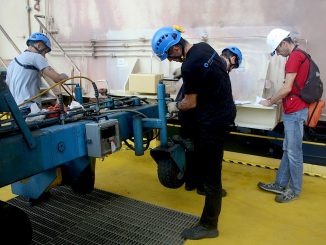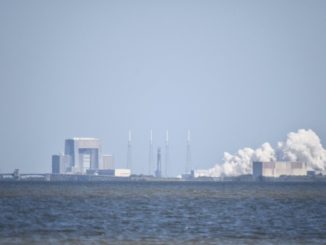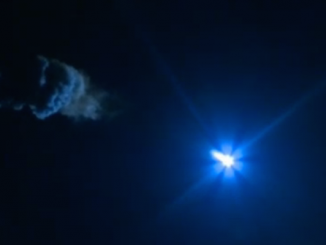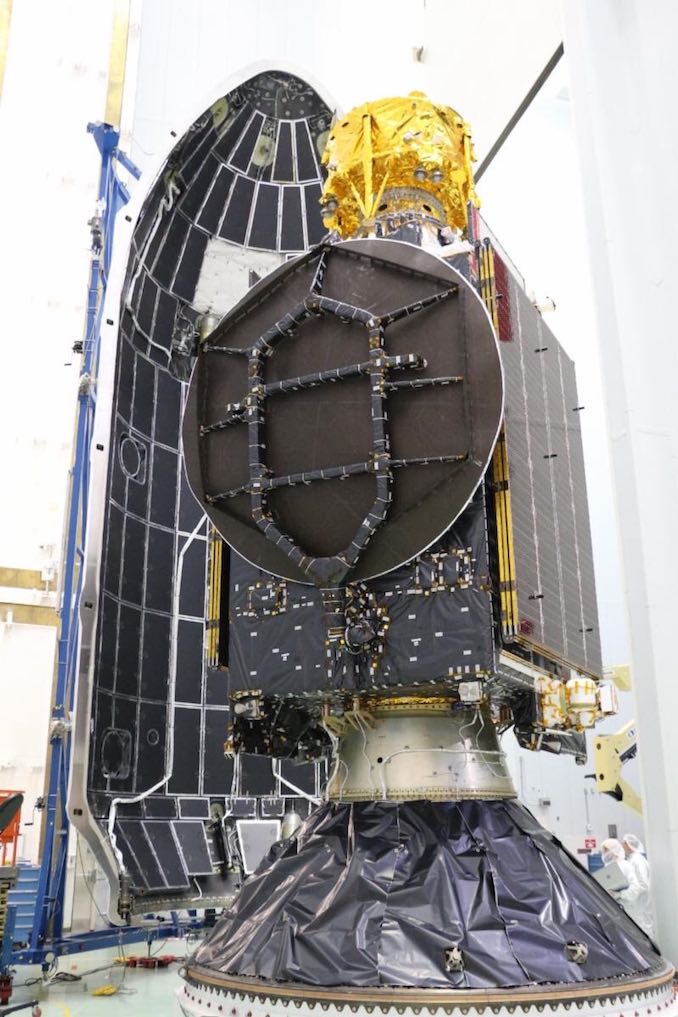
SpaceX is set to end a two-month launch drought at Cape Canaveral with a blastoff Thursday night carrying a privately-funded Israeli moon lander, an Indonesian communications satellite and a U.S. Air Force surveillance payload into orbit.
A Falcon 9 rocket will lift off during a 32-minute launch window opening at 8:45 p.m. EST Thursday (0145 GMT Friday).
The Falcon 9’s liftoff from Cape Canaveral’s Complex 40 launch pad will be the first launch from the Florida Space Coast since Dec. 23, and the first of up to 20 or so orbital-class missions planned from Florida this year.
There is an 80 percent chance of favorable weather during Thursday night’s launch window. A nearly full moon will rise minutes after the launch window opens.
Nine Merlin 1D main engines will push the Falcon 9 rocket off the ground with 1.7 million pounds of thrust.
SpaceX plans to recover the Falcon 9’s first stage aboard the company’s drone ship parked in the Atlantic Ocean a few hundred miles east of Cape Canaveral. Another ship in SpaceX’s fleet, Mr. Steven, could try to catch the rocket’s payload fairing when it descends back to Earth.
Mr. Steven arrived at Port Canaveral, a few miles south of the Falcon 9 launch pad, earlier this month after a trip from the Port of Los Angeles, through the Panama Canal and the Caribbean Sea, to its new staging base in Florida. The ship is fitted with a giant net suspended between four arms, a setup SpaceX has nicknamed the “catcher’s mitt,” to catch fairings as they descend under steerable parafoils.
The vessel attempted to catch the fairing after several launches from California, but narrowly missed snagging the Falcon 9’s shroud. SpaceX also practiced catching fairings with Mr. Steven in the Pacific Ocean after they were dropped from a helicopter.
Thursday night’s mission could mark Mr. Steven’s debut on the East Coast.
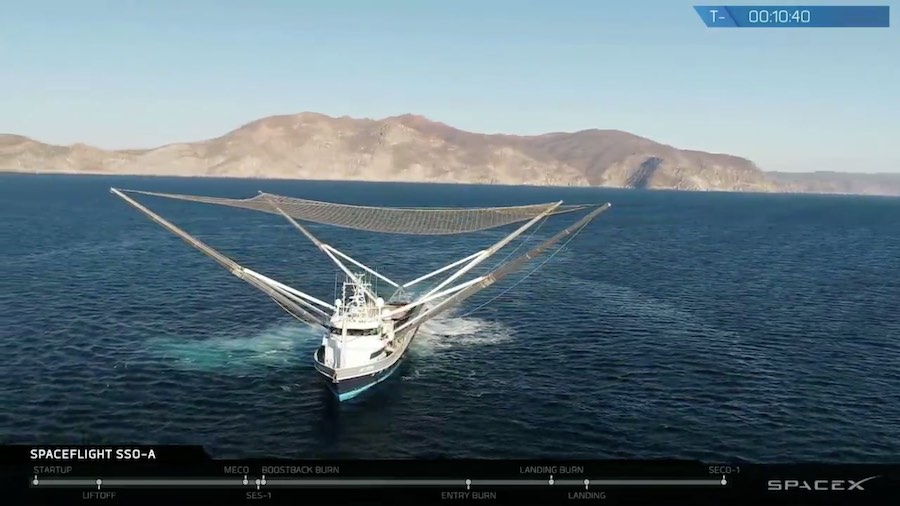
This week’s flight will be SpaceX’s second launch of the year overall, following a Jan. 11 flight from Vandenberg Air Force Base, California, with 10 Iridium communications satellites.
SpaceX test-fired the Falcon 9 rocket Sunday evening, then rolled the launcher back into its hangar for attachment to the mission’s payloads.
Three spacecraft will be stowed inside the Falcon 9 rocket’s payload fairing for launch.
The largest of the group is an Indonesian communications satellite named Nusantara Satu.
Built by SSL in Palo Alto, California, the Nusantara Satu satellite will provide voice, data and video distribution services throughout Southeast Asia, according to the spacecraft’s manufacturer.
The satellite is owned by PT Pasifik Satelit Nusantara, or PSN, an Indonesian telecom company. Formerly known as PSN 6, the satellite carries C-band and Ku-band transponders, along with a high-throughput payload for broadband services.
“(The) Nusantara Satu satellite is a very important infrastructure for Indonesia,” said Adi Rahman Adiwoso, CEO of PSN. “As the first Indonesian High Throughput Satellite, it is another monumental step for PSN to realize its dream and carry on its commitment to provide broadband services across the vast archipelago of Indonesia.”
The spacecraft — designed for a 15-year mission — will use electric thrusters to maneuver into a circular geostationary orbit more than 22,000 miles (nearly 36,000 kilometers) over the equator from an initial drop-off transfer orbit ranging between an altitude of a few hours hundred miles and approximately 37,000 miles (about 60,000 kilometers), an orbit reachable by the two-stage Falcon 9 rocket.
The Falcon 9 will fire its upper stage Merlin engine two times during Thursday night’s mission to reach the targeted supersynchronous transfer orbit around a half-hour after liftoff.
The Israeli Beresheet lunar lander, one of the mission’s secondary payloads, will separate from the launcher first. It is attached to the very top of the three-payload stack inside the nose of the 229-foot-tall (70-meter) Falcon 9 rocket.
The Beresheet spacecraft will use its own thrusters to spiral away from Earth, gradually raising its orbit until it intercepts the moon April 4.
The lander, with a fueled weight of around 1,283 pounds (582 kilograms), was originally developed to compete for the defunct Google Lunar X Prize. When that competition ended last year without a winner, the Israeli team — known as SpaceIL — continued their project, which is billed as the first privately-funded lunar lander.
The Beresheet spacecraft is also the first mission to attempt soft landing on the moon by a non-superpower, following probes sent by the United States, the Soviet Union and China.
Israeli officials say the lunar lander was developed for less than $100 million.
Assuming the craft reaches lunar orbit April 4 as scheduled, touchdown in the moon’s Mare Serenitatis region is scheduled for April 11.
The other piggyback payload launching Thursday is the S5 satellite for the Air Force Research Laboratory.
Unlike the Beresheet lander, S5 will remain mounted to the Nusantara Satu spacecraft during the communications satellite’s orbit-raising maneuvers.
Nusantara Satu will release the S5 spacecraft into an orbit near geosynchronous altitude, then head to its final orbital position.
S5 was described as a space situational awareness mission in a 2017 press release from Blue Canyon Technologies, a smallsat manufacturer in Colorado.
According to Blue Canyon Technologies, the spacecraft weighs about 132 pounds (60 kilograms), and carries a payload provided by Applied Defense Systems.
The U.S. military has launched several missions in recent years with optical sensors to scan geostationary orbit, where ground-based radars used to track satellites and space junk in low Earth orbit have difficulty detecting objects.
One such mission was SensorSat, which launched from Cape Canaveral in August 2017 to look up toward geostationary orbit from a low-altitude orbit hugging the equator. The Air Force has also launched four space surveillance satellites to rove geostationary orbit, with the ability to approach and inspect objects there.
S5 will demonstrate the capability of a small satellite to find objects in geostationary orbit, allowing the military to update its database, which is relied upon by commercial companies and international space agencies.
“The objective of the S5 mission is to measure the feasibility and affordability of developing low cost constellations for routine and frequent updates to the GEO (geostationary) space catalog,” Blue Canyon Technologies said in the 2017 statement.
The launch of the Beresheet moon probe and the military’s S5 mission was arranged by Spaceflight, a launch broker and rideshare provider based near Seattle. It will be Spaceflight’s first rideshare to geostationary transfer orbit, following numerous missions to low Earth orbit.
Spaceflight secured the rideshare launch service with SSL, which purchased the full capacity of the Falcon 9 rocket.
Email the author.
Follow Stephen Clark on Twitter: @StephenClark1.

